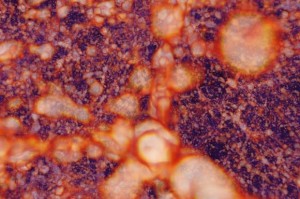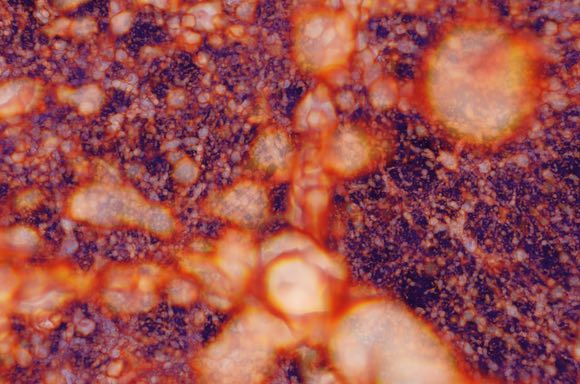
This image shows a large simulation of the distribution of matter in the Universe, the so-called cosmic web, which evolved under the influence of dark energy.
This week, the Argonne Leadership Computing Facility (ALCF) turns one decade old. ALCF is home to Mira, the world’s fifth-fastest supercomputer, along with teams of experts that help researchers from all over the world perform complex simulations and calculations in almost every branch of science. To celebrate its 10th anniversary, Argonne is highlighting 10 accomplishments since the facility opened its doors.
 Understanding the molecular basis of Parkinson’s disease
Understanding the molecular basis of Parkinson’s disease
Researchers ran simulations to understand how several proteins connected with Parkinson’s disease interact to cause the degenerative neurological disorder. The findings provide a test bed for identifying possible treatments via computer modeling.
Led by Igor Tsigelny, University of California-San Diego Improving airplane engines
Improving airplane engines
Inside a jet engine, air flowing faster than a hurricane is combined with fuel to generate heat that powers the plane. Designers are turning to supercomputers to model these complex processes to make new engines that are cleaner, quieter and cheaper — and a study at the ALCF was key to helping industry integrate these simulations into their design process. Improvements based on this work are now currently in use in aircraft.
Led by Peter Bradley, Pratt & Whitney Modeling detonations to transport explosives safely
Modeling detonations to transport explosives safely
Researchers modeled a 2005 explosion that left a 30-by-70-foot crater in a Utah highway, capturing the physics that made the truck’s cargo explode more violently than it should have. With such simulations, we can design safer transport for explosives.
Led by Martin Berzins, University of Utah Illuminating the early universe
Illuminating the early universe
One of the largest cosmological simulations ever run at the time, called the Outer Rim simulation, modeled the evolution of the universe over billions of years — allowing scientists to “watch” as galaxies form. This helps researchers understand how cosmic structures formed and how the mysterious force called dark energy played a role.
Led by Salman Habib, Argonne National Laboratory Puzzling out proteins that work against antibiotics
Puzzling out proteins that work against antibiotics
In the race against antibiotic resistance, computing is becoming a valuable tool for identifying new ways to fight disease. Researchers ran simulations on key pathogen proteins, including nine molecules that could work against anthrax as well as potential avenues to defeat a gene that confers resistance against one of the last strong antibiotics.
Led by T. Andrew Binkowski, Argonne National Laboratory Making concrete advances
Making concrete advances
Concrete is essential to modern life, but the process to make it releases a lot of greenhouse gases. To come up with new formulas that reduce emissions, scientists modeled the flow of concrete (a complex suspension of cement, water and sand or gravel) and found new principles that should help guide the making of new, greener types of concrete.
Led by William George, National Institute of Standards and Technology Better ways to analyze particle collisions
Better ways to analyze particle collisions
At the Large Hadron Collider in Europe, the most powerful accelerator in the world, physicists run simulations on the data collected from their particle collisions in order to understand the fundamental forces that make up the universe. But the LHC’s computing grid isn’t going to be powerful enough for long — so an exploratory team adapted the code to run on the architecture of more powerful supercomputers, which will let them run more data and simulate more complex events than are currently possible.
Led by Tom LeCompte, Argonne National Laboratory Adding renewables to the electric grid
Adding renewables to the electric grid
Adding renewable energy to the electric grid is tricky, because solar and wind generation fluctuate with weather conditions. A team of researchers used ALCF to demonstrate that a complex math called stochastic optimization can help grid operators minimize instability and distribute power as needed while minimizing the need for costly backup plants.
Led by Mihai Anitescu, Argonne National Laboratory Investigating how materials crack
Investigating how materials crack
When materials crack and corrode under stress, the process starts tiny — at the molecular level. Only supercomputers have the capability to run simulations so detailed that they actually show how cracks begin as atoms and molecules interact over time. These simulations can help researchers design possible solutions, such as self-healing nanomaterials, to build safer, stronger materials for high-stress environments.
Led by Priya Vashishta & Rajiv Kalia, University of Southern California Getting better at predicting climate change
Getting better at predicting climate change
When we want to know exactly how the climate might change in the future — which areas might have more drought, more floods, more heat — we turn to climate models. But predicting the future on a global climate scale is extraordinarily difficult; it’s so complex that slight changes to the parameters show different futures. The ALCF has been helping scientists run these enormous climate models and to refine the techniques to provide more accurate simulations.
Led by Warren Washington, National Center for Atmospheric Research




